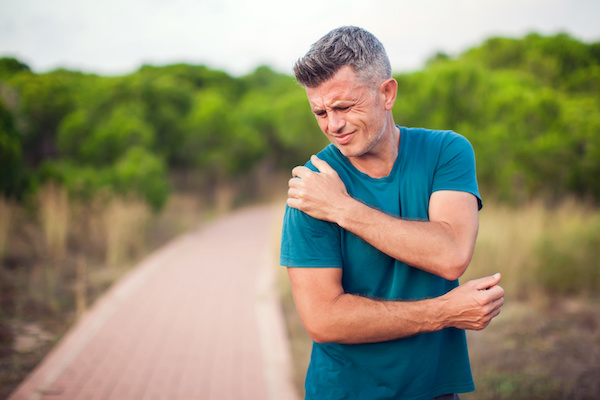Treating Joint Pain in a Natural Way
- Category: Health
- Published: Monday, 17 July 2023 09:44
- Joanne Wallenstein
 Contributed by Dr. Nicole Solomos, Lifestyle Medicine. The original version of this article was published in Health Matters, a White Plains Hospital publication.
Contributed by Dr. Nicole Solomos, Lifestyle Medicine. The original version of this article was published in Health Matters, a White Plains Hospital publication.
Nagging joint pain can affect not just your body, but also your mind and your mood. As a result, many people suffering from joint pain do so by remaining relatively sedentary, afraid that engaging in physical activity will only exacerbate their situation.
However, as a practitioner of lifestyle medicine, I strongly recommend that everyone – and not just those with joint pain – follow certain regimens that can help them change their lives for the better. Lifestyle medicine is a medical specialty that uses therapeutic lifestyle interventions as a primary technique in treating chronic conditions.
For the purposes of this article, I will be speaking in generalities; obviously, each individual is facing their own situation, and some are more capable of making these adjustments than others. Nevertheless, following these recommendations can help those with joint pain feel refreshed, renewed, and more able to deal with their challenges.
Regular physical activity/exercise. This cannot be stressed enough. Such activity can keep the muscles around affected joints strong, slow the loss of lean mass, and in some cases can help control joint swelling and pain. In addition, regular activity can help restore lubrication to the cartilage of the joint, thereby reducing stiffness and pain.
This proposal may strike some – especially the elderly and/or those with severe joint pain – as difficult to achieve. But that is not necessarily the case. Strength training, which has not been emphasized enough in our culture, can be done at any age (it’s never too late to start!) and doesn’t necessarily mean lifting large barbells or dumbbells over your head repeatedly. Body weight exercises like push-ups or modified squats can be a great way to start; there is a host of exercises utilizing chairs for extra support. Resistance training, done with resistance bands, sandbags, or even some household items are also recommended, as are core exercises like planking or others that involve lying on your back.
Remember: strength and mobility can be more important than emphasizing one’s weight or body size; they can even go hand in hand. You aren’t looking to compete in the next Iron Man; you are looking to get more fit and relieve the stress on your aching joints.
Nutrition. Defining what makes for a “proper” nutrition plan can be complicated; there is no one way that’s right for everyone. For that reason, I recommend that each person comes up with their own customized eating plan rather than relying solely on someone else’s suggestions. The latter will usually prove to be unsustainable, and you might simply give up after a few weeks or months.
That said, I consider the Mediterranean diet to be the gold standard, with its emphasis on plant-based foods and healthy fats; details can be found here. Processed foods should be avoided, and you should be aware that your preferred intake of protein will vary as you get older, especially for women; those in peri- or post-menopause should be eating differently than those who are pre-menopause.
Risky substances. We all know (or should know) that smoking is a habit that should not be indulged. The same is true for alcohol; despite its normalization in our society – how many beer commercials do you see during a televised sporting event? – I feel that alcohol should be cut out of one’s life entirely. I realize that isn’t a particularly popular notion, but if you can’t keep it down to 0 drinks a week, try to limit it to no more than two drinks a day for men and no more than one drink a day for women, as the CDC suggests.
Caffeine is also a risky substance. Again, moderation is key; I feel that a single cup in the morning should be sufficient. Otherwise, you may be prone to feeling jittery/nervous, dehydrated, and/or having an increased heart rate. Too much caffeine or alcohol can have a negative impact on your sleep – and, thus, on your joint pain.
Sleep. An adequate amount of sleep allows your body to maintain healthy brain function and good physical health. Joint pain can result in restless sleep – without movement, your joints can stiffen during the night – and a lack of sleep can aggravate the pain. The exercises and other healthy habits listed above can help alleviate this problem.
Less than the recommended 7 to 8 hours a night may increase your chances of not only exacerbating joint pain, but also in developing chronic health problems. Dr. Nicole SolomosWater. Drinking enough water each day is one of the keys to sustaining a healthy lifestyle. The general guideline here is to take in at least 64 ounces of water a day (age, sex and activity levels may alter that recommendation). Water helps in maintaining healthy tissue as well as healthy joints. Water also is an excellent alternative to alcohol for a number of reasons; in addition, it can help fill you up, thus eliminating the urge for between-meal snacks.
Dr. Nicole SolomosWater. Drinking enough water each day is one of the keys to sustaining a healthy lifestyle. The general guideline here is to take in at least 64 ounces of water a day (age, sex and activity levels may alter that recommendation). Water helps in maintaining healthy tissue as well as healthy joints. Water also is an excellent alternative to alcohol for a number of reasons; in addition, it can help fill you up, thus eliminating the urge for between-meal snacks.
Following these guidelines will probably not eliminate your joint pain, especially if you have a chronic condition like arthritis. But it can definitely help alleviate at least some of it, which in turn will result in feeling both happier and healthier.
Dr. Nicole Solomos is board-certified in Sports Medicine/Family Medicine and in Lifestyle Medicine. To make an appointment, call 914-849-7075 (Somers) or 914-631-7777 (Hawthorne and Yonkers).










